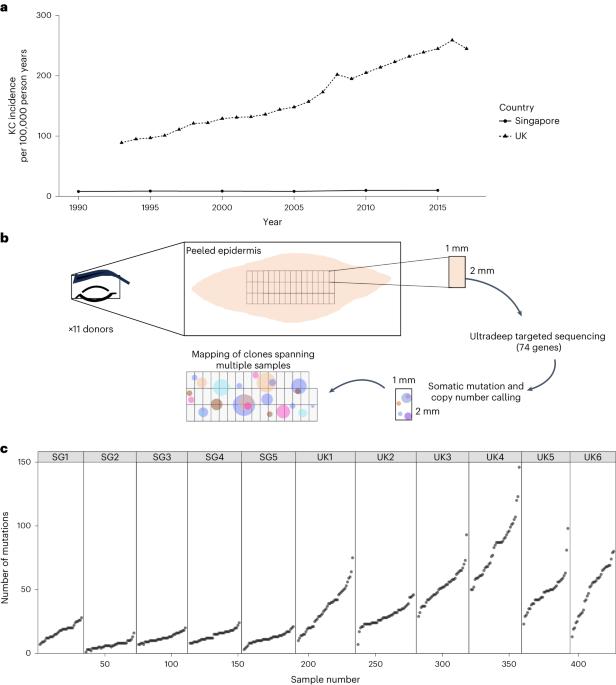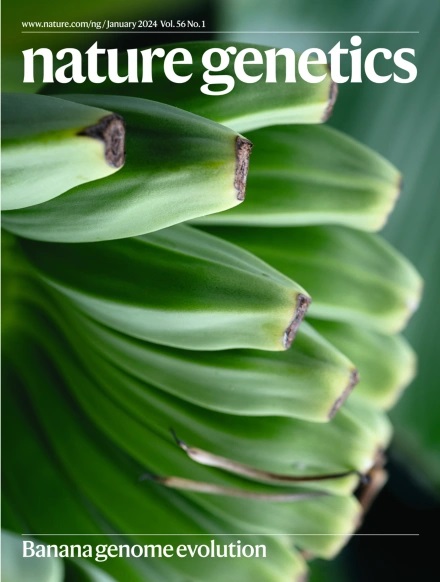Somatic mutations in facial skin from countries of contrasting skin cancer risk
IF 31.7
1区 生物学
Q1 GENETICS & HEREDITY
引用次数: 3
Abstract
The incidence of keratinocyte cancer (basal cell and squamous cell carcinomas of the skin) is 17-fold lower in Singapore than the UK1–3, despite Singapore receiving 2–3 times more ultraviolet (UV) radiation4,5. Aging skin contains somatic mutant clones from which such cancers develop6,7. We hypothesized that differences in keratinocyte cancer incidence may be reflected in the normal skin mutational landscape. Here we show that, compared to Singapore, aging facial skin from populations in the UK has a fourfold greater mutational burden, a predominant UV mutational signature, increased copy number aberrations and increased mutant TP53 selection. These features are shared by keratinocyte cancers from high-incidence and low-incidence populations8–13. In Singaporean skin, most mutations result from cell-intrinsic processes; mutant NOTCH1 and NOTCH2 are more strongly selected than in the UK. Aging skin in a high-incidence country has multiple features convergent with cancer that are not found in a low-risk country. These differences may reflect germline variation in UV-protective genes. A comparison of somatic mutations in skin from individuals from the UK and Singapore suggests that the difference in cancer incidence between the two countries is due to markedly different mutational spectra and patterns of selection.

面部皮肤中的体细胞突变与癌症风险形成对比。
新加坡的角质形成细胞癌症(皮肤基底细胞癌和鳞状细胞癌)的发病率比UK1-3低17倍,尽管新加坡接受的紫外线(UV)辐射是UK1-3的2-3倍4,5。衰老的皮肤含有体细胞突变克隆,这些癌症就是从这些克隆中发展出来的6,7。我们假设角质形成细胞癌症发病率的差异可能反映在正常的皮肤突变景观中。在这里,我们发现,与新加坡相比,英国人群的衰老面部皮肤具有四倍大的突变负担、主要的紫外线突变特征、增加的拷贝数畸变和增加的突变体TP53选择。这些特征在高发病率和低发病率人群的角质形成细胞癌中是相同的8-13。在新加坡皮肤中,大多数突变是由细胞内在过程引起的;与英国相比,突变型NOTCH1和NOTCH2的选择更为强烈。在高发病率国家,衰老皮肤具有与癌症融合的多种特征,而在低风险国家则没有发现这些特征。这些差异可能反映了紫外线防护基因的种系变异。
本文章由计算机程序翻译,如有差异,请以英文原文为准。
求助全文
约1分钟内获得全文
求助全文
来源期刊

Nature genetics
生物-遗传学
CiteScore
43.00
自引率
2.60%
发文量
241
审稿时长
3 months
期刊介绍:
Nature Genetics publishes the very highest quality research in genetics. It encompasses genetic and functional genomic studies on human and plant traits and on other model organisms. Current emphasis is on the genetic basis for common and complex diseases and on the functional mechanism, architecture and evolution of gene networks, studied by experimental perturbation.
Integrative genetic topics comprise, but are not limited to:
-Genes in the pathology of human disease
-Molecular analysis of simple and complex genetic traits
-Cancer genetics
-Agricultural genomics
-Developmental genetics
-Regulatory variation in gene expression
-Strategies and technologies for extracting function from genomic data
-Pharmacological genomics
-Genome evolution
 求助内容:
求助内容: 应助结果提醒方式:
应助结果提醒方式:


